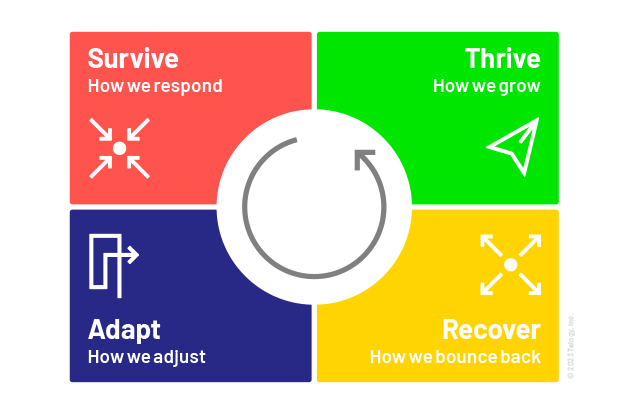Written by Dr. Jo Maddocks, Chief Psychologist
Across the globe, we are individually and nationally at different stages in how we respond, manage, and – all being well – recover from the COVID-19 pandemic. There are four stages we transition through in coping with adversity, and the Talogy Thrive Cycle of Resilience outlines the psychological stages of coping with change and adversity. In this blog, I will discuss the first of these four stages (Survive), with advice on how to successfully work through this stage in relation to the current pandemic and lock down. Stay tuned for future blogs, where I will cover each of the subsequent stages of the Thrive cycle.
The Talogy Thrive Cycle of Resilience
- Survive: How we initially respond to adversity
- Adapt: How we adjust to change and adversity
- Recover: How we bounce back from setback and adversity
- Thrive: How we grow and become more resilient following adversity

Each stage may last for different periods of time. Sometimes we become stuck at one of these stages, which makes it difficult to move on to the next stage. It is important to recognise that going through each phase is normal and necessary. At the start of the COVID-19 crisis, there was a strong temptation to deny or ignore the potential dangers, and it took a while for many of us to reach the Survive stage. We chose to cling on to the false hopes and disinformation that suited our views: “It won’t reach us in the West”, “It’s just the common cold”, “It only affects older people”, “Washing our hands is the solution”. Yet, reality is reality, and most of us when faced with adversity will sooner or later fall into the survival zone for a period of time. How long we spend in this zone will depend on many factors, one of which is our level of resilience.
The Survive Stage
The survival stage is characterised by feelings of fear and anxiety that may cause us to overreact and bring out the worst in our behaviour. Think of the panic buying in shops, blaming others for passing on the virus, and looking after ourselves at the expense of others, to give several examples. What’s important is that we don’t get stuck in this phase. The risk is that we catastrophise and exaggerate problems. Our brains are hard-wired to focus on bad news, of which there is no shortage at present. Every day we are updated on how many more people died from the virus. Can you imagine if this is what we did for all the other illnesses, accidents, and fatalities that still occur every day in every country across the globe? How depressing life would be! I noticed recently in the newspaper a single small paragraph describing another terrorist atrocity in France. Only a few weeks ago this would have been front-page news, created international outrage, and been the focus of our attention. Where we focus our attention is to a large extent our reality. In order to move on from the Survival stage to the Adapt stage, we need to redirect our attention away from fear and anxiety towards more positive and constructive emotions, such as acceptance, hope, and appreciation.
- Focus attention: One way to do this is to focus our attention on positive information and away from negative thoughts. For example, appreciating the unusually good weather, not having the daily commute to work, enjoying the quietness on the roads, and valuing time with family members.
- Positive imagination: Another way is to focus our imagination on positive outcomes instead of negative expectations. Remember, our brain is hard-wired to focus on threats, risks, and danger. Given free reign, our imagination will default to what could go wrong, causing us to feel anxious and worried. To compensate for this natural tendency, we must actively use our imagination to focus on positive outcomes and possibilities instead. For example, what are you looking forward to? How could you make things better? What is the best possible outcome?
- Positive language: One further consideration is our use of language. Negative language is a contagious disease in much the same way as the physical virus. At the start of the epidemic in the UK, much of the media were in a frenzy of apocalyptic proportions. Many of those in my profession reinforced the message that we are all in crisis, experiencing unprecedented levels of anxiety, and in need of psychological help. It is important to distinguish between a global crisis and ourselves being in crisis. There are many individuals whose lives are in genuine crisis, but there are many more whose crisis is self-perpetuated through constant negative affirmation. Our brain is a pattern-matching organ, if we perpetually use phrases like crisis, disaster, and depression to describe ourselves, then our unconscious brain will spend its time looking for confirmation of these expectations and create a continuous negative spiral. If we want to reduce our anxiety and create a more positive mindset then we need to use more positive language and affirmations instead.
- A positive mindset: A positive or “Thrive mindset” is the opposite to a “Survive mindset.” Under stress, the brain switches to a more primitive survival mode – to protect and conserve – even though the best way to survive modern-day difficulties is to look for opportunities and be creative. This is evidenced by the fight, flight, or freeze response to a perceived threat, also termed an “emotional hijack”. Although beneficial under life-threatening situations this survival response can have other negative side effects such as a catastrophic reduction in IQ, incapacity to think rationally, and impaired problem solving. By adopting and habitually practicing a positive thrive mindset, people can counter the brain’s negative default setting.
In my next blog, I will discuss the second stage of the Thrive cycle in relation to the pandemic and lock down and how we adapt to change and adversity.




